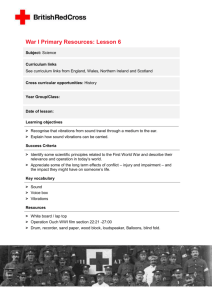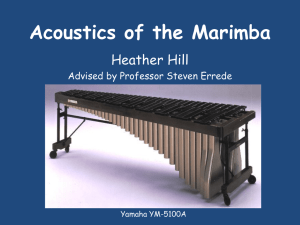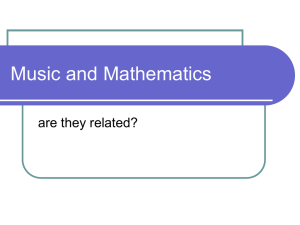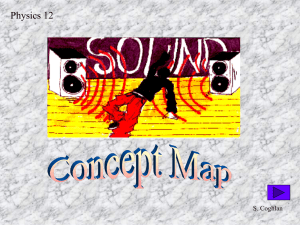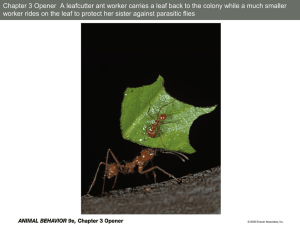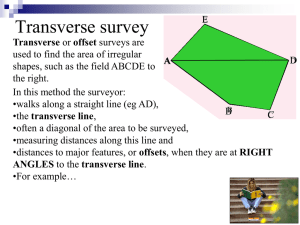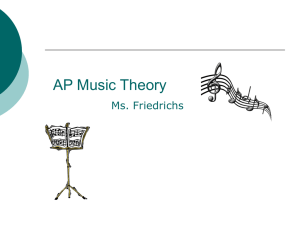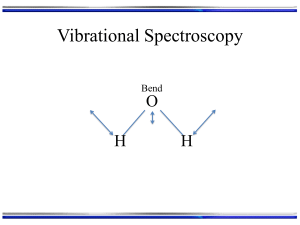lecture21
advertisement
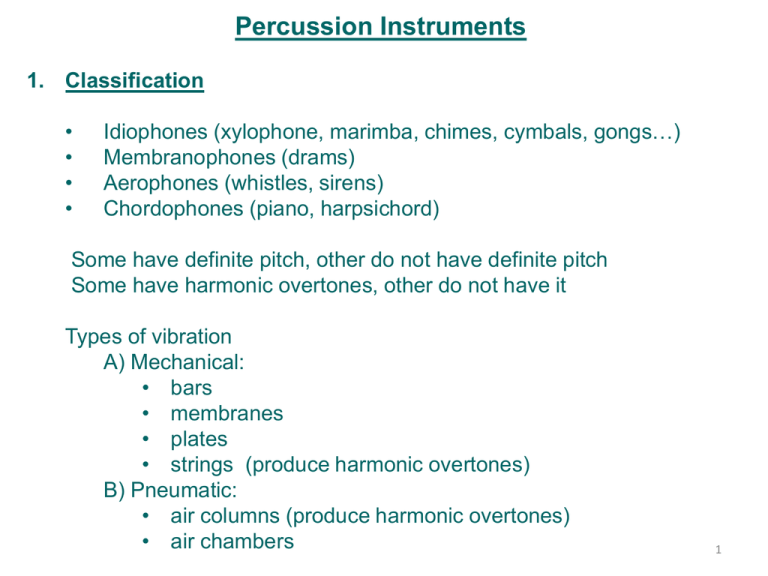
Percussion Instruments 1. Classification • • • • Idiophones (xylophone, marimba, chimes, cymbals, gongs…) Membranophones (drams) Aerophones (whistles, sirens) Chordophones (piano, harpsichord) Some have definite pitch, other do not have definite pitch Some have harmonic overtones, other do not have it Types of vibration A) Mechanical: • bars • membranes • plates • strings (produce harmonic overtones) B) Pneumatic: • air columns (produce harmonic overtones) • air chambers 1 2. Vibrations of bars • Longitudinal vibrations • Transverse vibrations A) Longitudinal vibrations (aluminum singing rods) • Harmonic modes (similar to a pipe with both ends open) nn / 2 L n 2 L / n f n v nv / 2 L v E/ E – Young’s modulus, ρ – density. • It is possible selectively excite desired mode by clamping at the location of one of the nodes for the particular mode. • Longitudinal vibration are much higher in frequency then transverse. Example: L=61cm, v=5100m/s f1 v / 2L 5100m / s 2 0.61m 1480hz 2 B) Transverse vibrations (almost always) • Boundary conditions: • Free (almost always) • Clamped • Simply supported • Modes are not harmonic (because of that description is more complicated) • Frequency depends on thickness t, length L, and speed of sound v • Frequency of transverse vibrations in a bar with free ends: f m vK / 8L2 m 2 m 3.0112, 5, 7, 9,... K t / 12 t / 3.46 for a rectangular bar. K for a tube with inner radius a, and outer radius b. 1 2 a2 b2 • Frequency ratios: 1.00 : 2.76 : 5.40 : 8.90 … (not harmonic) Note! Frequency •decrease as L2 rather then L •increase as m2 •depend on shape (K – radius of gyration) 3 2a. Aluminum singing rods Longitudinal vibrations: f n v nv / 2 L n 1, 2, 3,... Transverse vibrations: f m m 2va / 16L2 m 3.0112, 5, 7, 9,... Question: Is it possible to have longitudinal and transverse fundamentals coincide? Question: Why from aluminum? Physics Fairy performing the singing rod http://www.physicscentral.com/ experiment/physicsathome/rod .cfm Singing rod demo: http://www.arborsci.com/singing-rods-set-of-2 4 2b. Rectangular bars: the glockenspiel • Rectangular steel bars 2.5 – 3.2 cm wide and 0.6 to 1.0 cm thick • What about length? • f = 786 - 4186 Hz (G5 – C8) Modes: • Transverse • Torsional • Transverse exited edgewise 5 2c. Marimba • Tuned bars of rosewood or fiberglass with tubular resonator (3-5 octaves) • f=110 – 2093 Hz (A2 –C7) • A deep arch is cut in the underside of bars to • reduce the length of bar required to reach the low pitches • allows tuning of overtones •Resonators: • Cylindrical pipes with one end open and one end closed • These pipes are tuned to fundamental mode of the corresponding bar • Purpose of the resonator is to emphasize the fundamental and to increase loudness 6 2d. Xylophone (Wooden sound. In Greek: xylon. "wood" + phonē, "sound, voice“) The term may be used generally, to include all such instruments, such as the marimba and balafon or, more specifically, to refer to an orchestral instrument of somewhat higher pitch range than the chromatic marimba. It is sometimes mistakenly used of similar lithophones and metallophone instruments of the glockenspiel type such as the pixiphone. •Bars from rosewood or synthetic materials •Modern have tubular resonators •Cover 3 to 3.5 octaves •First overtone has frequency three times of the fundamental (closed pipe can resonate at this frequency) 7 2e. Chimes •Chimes partials: 92:112:132 = 81:121:169 ~ 2:3:4 •If partials are not harmonic, peach is picked up from the nearly harmonic partials near the center of audible range •Chimes do not have partials near the fundamental – pitch is purely subjective •Virtual pitch – missing fundamental (Similar situation in bells. However bells have weak fundamental) 8 3. Vibrations of membranes •Membrane may be considered as two-dimensional string •Restoring force is tension applied from the edge •Can be tuned by changing tension •Mode frequencies are not harmonic (in ideal string they are harmonics) •Node lines (instead node points in strings) 3a. Circular membranes •Nodal lines are circles and diameters •Frequencies of vibrational modes: a T radius of membrane f nm 1 T nm 2a surface tension (force divided by the length of the circle [N/m]) area density (mass divided by area [kg/m]) nm values for which Bessel functions becames zero 9 Circular Membrane Modes The four lowest vibrational modes for a circular membrane. 10 4. Vibration of plates • Vibrations of plates relate to the vibrations of membranes the same way as vibrations of bars relate to the vibrations of strings • In string and membranes restoring force is tension • In bars and plates restoring force is stiffness of bulk material • Circular plates can vibrate in different modes often labeled as m and n 4a. Cymbals • Consist of thin, normally round plates • Could be excited in many different ways: • struck at various points • struck with wooden stick or soft beater • struck with another cymbal • The coupling between different modes in cymbals is strong. Because of that, a large number of partials quickly appears in the spectrum • Cymbals exhibit nonlinear behavior • bifurcations and chaos • phase diagrams (plots) 11
